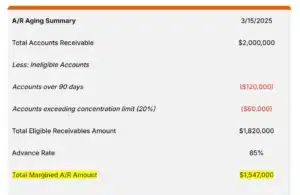Summary: Small middle-market companies have fewer financial options than their larger counterparts. Large companies have choices comparable to those of small companies. However, they benefit from better pricing. This article discusses cash flow financing options available to lower middle-market companies. It also includes options that are available to distressed companies. We cover the following: 1. […]
Asset Based Lending
Navigating Asset-Based Loans: Small Business Guide
Asset-based loans (ABLs) enable companies to get financing by leveraging their accounts receivable, inventory, and other assets. These loans are a popular option for companies due to their flexibility, simpler qualification requirements, and easier compliance. This guide helps business owners understand how ABLs work, which assets can be financed, what lenders look for, and how […]
Financing Options for Distressed Lower Middle-Market Companies (“Special Assets”)
Summary: Middle-market companies that are out of compliance with their lenders are typically assigned to the Special Assets group. Usually, these companies must find a new lender as part of their workout process. Few lenders finance distressed companies in this market segment. Consequently, finding a replacement lender can be a significant challenge for lower middle-market […]
How Does a Borrowing Base Certificate Work?
A borrowing base certificate is a document that a company uses to draw funds from its asset-based loan (ABL). The certificate is typically used in ABLs secured by accounts receivable since these loans are structured as revolving lines. This article explains how borrowing certificates work and covers the following: 1. What is a borrowing certificate? […]
Asset-Based Loan Qualification Requirements
Summary: Asset-based loans are commonly used by small and middle-market companies that need financing. Their main advantage is that they offer a flexible structure and support several types of collateral. Asset-based loans are popular with companies because these loans have fewer covenants and simpler qualification requirements than bank financing. Read “What is an Asset-Based Loan? […]
What is Special Assets? What Should You Expect?
Summary: The Special Assets department handles loans that are out of compliance and in trouble. Lenders assign loans to this department to mitigate potential losses. This change marks a turning point in your relationship with the lender, as they likely want to exit the lending relationship. A company can improve its chances of success in […]
Asset-Based Loans – Costs and Rates Explained (Small Business)
Asset-based loans (ABLs) are a type of financing that enables companies to get funding based on their assets. These loans are popular among small and midsize businesses because they offer simpler qualification and compliance requirements. While asset-based loans are more expensive than conventional bank financing, they are cheaper than most other solutions. This article discusses […]
What is an Asset-Based Financing Line of Credit?
Summary: An asset-based line of credit is a specialized type of asset-based loan. It provides a revolving line of financing that must be secured by Accounts Receivable (A/R). Some lines can also finance Inventory as long as the A/R is included in the transaction. These lines are often used by small and mid-sized companies that […]
Do You Need Collateral for a Line of Credit?
Getting a business line of credit can be a challenge for small business owners. Most lines are difficult to qualify for and have hefty collateral requirements. For many business owners, this challenge represents an obstacle that a few businesses can overcome. From this article you will learn: Why all lines of credit need collateral The truth about […]
What is Invoice Financing? How Does it Work?
Invoice financing is a general term that applies to several products that allow you to finance accounts receivable. The two most-used solutions are factoring and sales ledger financing. In this article, we discuss both solutions in detail. The article covers: 1. Quick Summary Factoring allows your company to sell its invoices to improve your cash […]















